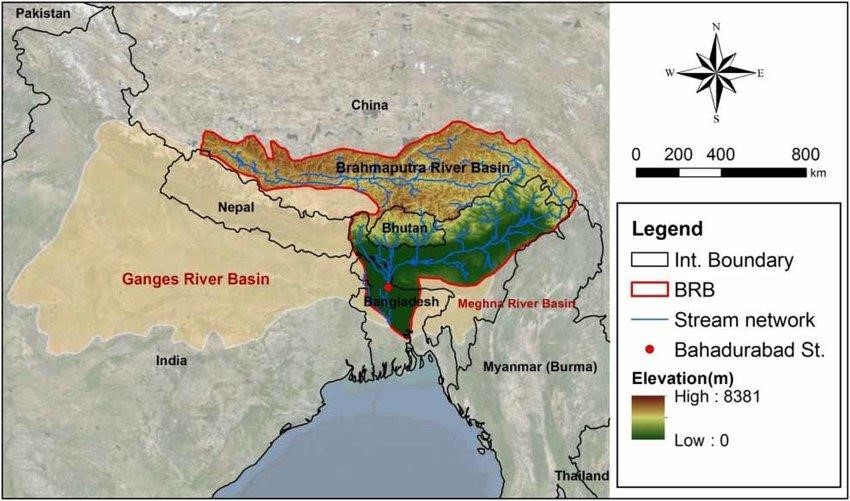Brahmaputra Basin Dams: Geopolitical Tensions and Environmental Risks
Syllabus:
GS-1: Water Resources
GS-2: India and its Neighbourhood , Effect of Policies & Politics of Countries on India’s Interests
GS-3: Conservation
Focus:
China’s ambitious mega-dam project on the Brahmaputra at the Great Bend has raised concerns over its environmental impact and its geopolitical implications for India, Bangladesh, and Bhutan. The growing competition for hydropower development in the basin has sparked fears of significant downstream consequences.
Introduction: Importance of the Brahmaputra River Basin
- The Brahmaputra is a transboundary Himalayan river system spanning four riparian nations: China, India, Bhutan, and Bangladesh.
- It originates in the Tibetan Autonomous Region (TAR) as the Yarlung Zangbo and flows through India and Bhutan before draining into Bangladesh and the Bay of Bengal.
- The river basin is a key water resource for millions, supporting agriculture, biodiversity, and livelihoods across the region.
Key Points on Brahmaputra:
- Originates as Siang/Dihang from Chemayungdung Glacier near Mansarovar Lake in the Kailash Range, entering India at Sadiya in Arunachal Pradesh.
- Major tributaries include Dibang, Lohit, Siang, Burhi Dihing, Tista, and Dhansari.
- A perennial river with unique geographical and climatic features.
- Experiences two annual floods: one from Himalayan snowmelt and the other from monsoon rains.
- Flood frequency has increased due to climate change, impacting food security in India and Bangladesh.
- River is dynamic, frequently shifting its course due to landslides and geological activity.
China’s Mega-Dam Project
- Project Overview:
- China plans a massive hydropower project at the Great Bend in Medog County, TAR.
- The 60 GW dam, included in China’s 14th Five-Year Plan and approved in 2024, is set to become the world’s largest hydropower project.
- Geopolitical Implications:
- The dam raises significant concerns for downstream nations, especially India and Bangladesh.
- The construction symbolizes China’s strategic control over Asia’s water tower and Tibet’s rivers.
Hydropower Dam Race in the Brahmaputra Basin
- China’s Efforts:
- China has developed projects like the Zangmu Dam (2015) and continues unilateral hydropower expansion.
- These dams are seen as sovereignty markers and tools for geopolitical leverage.
- India and Bhutan’s Initiatives:
- India plans its largest dam at Upper Siang to counter China’s efforts.
- Bhutan is constructing several medium and small-scale dams, raising concerns in India and Bangladesh.
- Lack of International Framework:
- None of the riparian nations are signatories to the 2014 UN Convention on Non-Navigational Uses of International Watercourses.
- Agreements like the 2006 Expert Level Mechanism (ELM) between India and China are insufficient for comprehensive water governance.
Risks for Communities and Ecosystems
- Disruption to Traditional Livelihoods:
- Local communities rely on centuries-old practices shaped by the river’s natural flow.
- Mega-dams disrupt these practices, making traditional knowledge
- Environmental and Social Impact:
- Blocking the perennial flow at the Great Bend could alter monsoon patterns, groundwater systems, and surface water availability.
- Downstream agrarian communities in India and Bangladesh face catastrophic risks to agriculture and livelihoods.
- Sensitive Himalayan ecosystems, biodiversity, and wetland systems are threatened by altered river cycles.
Tibet’s River Systems and Global Relevance
- Cryosphere and Climate Role:
- Tibet’s river systems, comprising glaciers and permafrost, are vital to the Earth’s cryosphere and influence global climate and precipitation patterns.
- Increased Glacial Lake Outburst Floods (GLOFs) due to climate change exacerbate risks.
- Historical Context:
- The 1950 Medog Earthquake caused devastating floods downstream, highlighting the fragile geological setting of the Brahmaputra basin.
Alternatives to Escalating Dam Construction
- China’s Perspective:
- The Yarlung Zangbo is historically considered a “rogue river” due to its sharp course changes. Mega-dams are viewed as measures to “discipline” the river.
- India’s Role:
- India should avoid replicating China’s approach and instead assume leadership by promoting sustainable transboundary water management.
- Prioritizing ecological preservation over territorializing rivers can prevent turning the Himalayan basin into a disaster-prone region.
Way Forward:
- Regional Cooperation:
- Riparian countries must move towards a bioregional framework for managing shared river systems.
- Collaborative governance could desecuritize the Brahmaputra basin and protect Himalayan ecosystems.
- Holistic Decision-Making:
- Policies should integrate geological history, climate resilience, and community needs.
- A focus on sustainability can balance development goals with ecological preservation.
- Academic Insights:
- Books like Rivers of the Asian Highlands offer critical perspectives on river systems’ long-term significance and vulnerabilities.
- These insights underscore the need for broader planetary thinking over narrow, nation-centric approaches.
Conclusion:
- The Brahmaputra river basin, a lifeline for millions, is under significant threat from mega-dam projects by China, India, and Bhutan.
- A shift towards cooperative management and ecological sustainability is essential to prevent irreversible damage to the region’s communities, ecosystems, and hydrological systems.
Source: Indian Express
Mains Practice Question :
Discuss the geopolitical and environmental implications of the ongoing hydropower projects in the Brahmaputra river basin. How will China’s plans for a mega-dam at the Great Bend impact its downstream neighbors, and what measures can be taken to address the challenges posed by these interventions?




